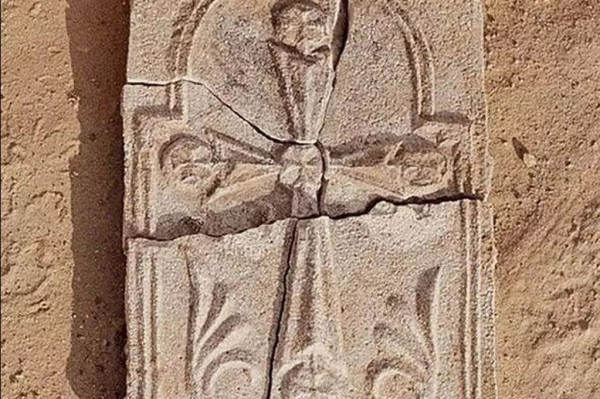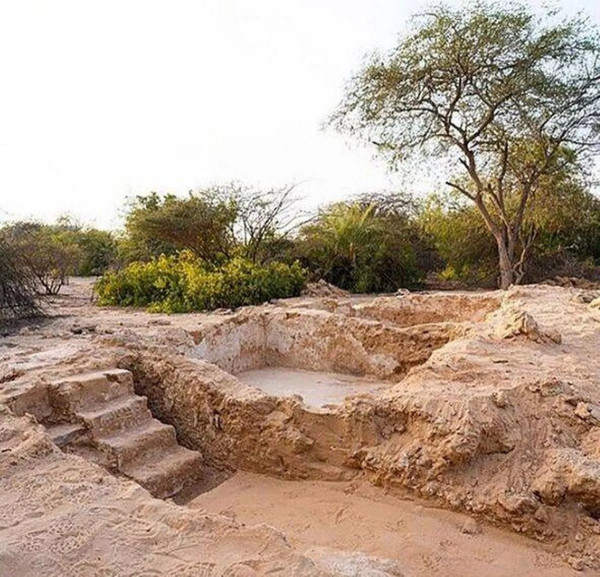
A 1,400-year-old plaque depicting a cross is reshaping understanding of how far east Christianity sp(Image: Department of Culture and Tourism)
Ishtartv.com - mirror.co.uk
By Michael D. Carroll, 20 Aug 2025
A 1,400 year old plaque showing a cross is transforming
experts' knowledge of Christianity's eastward reach.
Researchers excavating Abu Dhabi's Sir Bani Yas Island discovered the
relic, which displays a stepped pyramid reminiscent of Golgotha - the site
where Christians believe Jesus was crucified - with foliage emerging
from its foundation, according to the Daily Mail.
The artefact was unearthed amongst the remains of a church and
monastery, suggesting a Christian settlement that prospered on the island
throughout the seventh and eighth centuries, while recent reports show
how a previously unexplored 'Area X' begins to give up its religious
secrets.
Early Christians
Christianity during this era is commonly linked with the Levant,
Mesopotamia and sections of Europe, making proof of a flourishing community on
a southeastern Arabian Gulf island both surprising and historically important,
, reports the Express.
Simultaneously, the area was experiencing dramatic religious
transformation as Islam was emerging and expanding swiftly throughout Arabia,
whilst ancient pagan customs persisted and Christianity was believed to be
declining.
Nevertheless, the existence of a thriving Christian settlement here
contradicts that belief.
Christianity flourished
Maria Gajewska, chief archaeologist at the location, explained:
"Every element of the cross incorporates regional motifs.
"It tells us that Christianity in this region was not only present
but flourished, adapting visually to its local context. We had settlements of
Christians that were not just existing but were clearly thriving."
Mohamed Khalifa Al Mubarak, chairman of the Department of Culture and
Tourism, hailed the discovery as "a powerful testament to the UAE's
profound and enduring values of coexistence and cultural openness," adding
that the find underscores a history of peaceful religious diversity in the
region.
This season's excavations also unearthed pottery, glass artefacts and a
small seagreen bottle that may have contained oil or rosewater.
The cross itself measures about 10.6 inches long, 6.7 inches wide and
roughly 0.8 inches thick.
Archaeologists speculate it could have been an object of veneration,
mounted on a wall with worshippers kneeling before it.
Hager Al Menhali, an Emirati archaeologist at the department, told The
National: "The plaster was resting face down and something about it caught
my attention."
She noted a "distinct fingerprint on the back," suggesting it
was left by the person who crafted the stucco plaque.
Future studies will involve radiocarbon dating and further exploration
of the courtyard houses, which could eventually be incorporated into a broader
visitor trail.
"These discoveries deepen our connection to the past and inspire
future generations to embrace the spirit of unity and mutual respect that has
long defined our community," Al Mubarak said.
Findings from the dig suggested that senior monks may have resided in
the courtyard buildings, making their way to the church for worship or
utilising the spaces for spiritual retreats.
The well-constructed structures, built from limestone and coral with
water cisterns, indicate a comfortable lifestyle rather than a purely hermitic
existence.
The Christian community was part of the Church of the East, a
denomination that extended from the Middle East to China.
The Sir Bani Yas find provides a rare insight into how Christianity not
only endured but flourished eastward, connecting Arabian Gulf communities to
the broader narrative of the faith's expansion towards India and Asia.
Sir Bani Yas
Signs of a church and monastery on Sir Bani Yas, dating to the seventh
and eighth centuries, were first unearthed in the early 1990s.
A further monastery, probably connected to the same church, was found on
an island in Umm Al Quwain in 2022. Comparable sites have also been located in
Kuwait, Iran and Saudi Arabia.
Archaeologists continue to examine why the Sir Bani Yas settlement went
into decline.
The church is thought to have been fracturing before Islam's emergence,
plagued by internal divisions as competing branches pursued independence.
However, historical evidence indicates that early Christian and Islamic
communities in the area coexisted peacefully and engaged in trade.
To date, no external event has been pinpointed as the reason for the
site's desertion.
Intriguingly, archaeologists have noted that the buildings seem
remarkably tidy, with scant evidence of collapse or debris. This implies that
the inhabitants may have departed voluntarily, intending to return, rather than
being driven away by catastrophe or strife.

Archaeologists are still investigating why the Sir Bani Yas settlement declined.(Image: Department of Culture and Tourism)
|